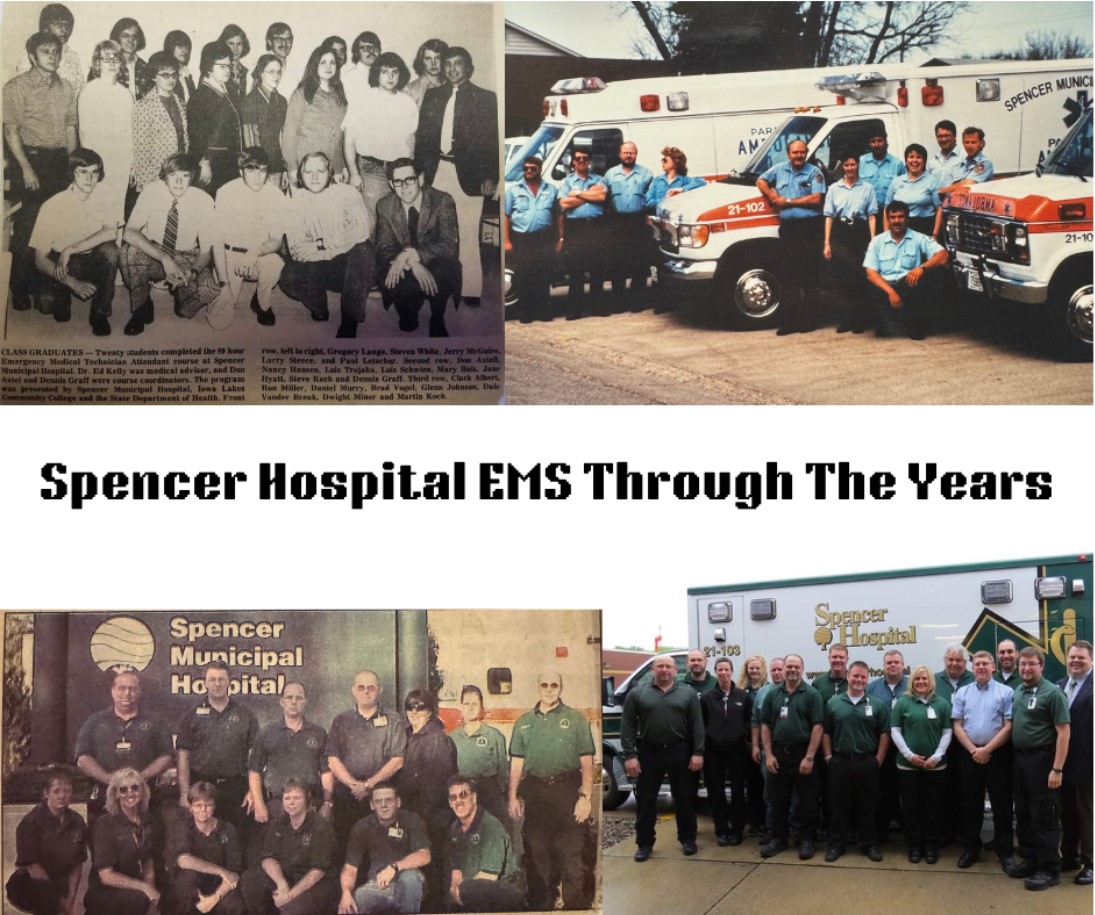Celebrating EMS Week: Honoring Spencer Hospital's Dedicated EMS Family
posted by Jessica & Jacob Moermond on Thursday, May 23, 2024
Emergency Medical Services (EMS) week is here! This national celebration highlights the dedication and hard work of all EMS providers, from full-time professionals to volunteers. At Spencer Hospital, our EMS family has evolved over the years, but our commitment to providing exceptional care and our mission of being “Healthier Together” remains steadfast.
A Glimpse into History
Every business has a timeline. Spencer Hospital’s Emergency Medical Services timeline began around 1972 with its first graduating class of EMT students. In 1982, Spencer Hospital became the first paramedic service in northwest Iowa. By 2002, Spencer Hospital’s paramedic ambulance services were the first in a 16-county region to be certified as a Critical Care Ambulance Service. Notably, Brian Trojahn, one of the first critical care paramedic providers for Spencer Hospital continues to serve on our Ambulance Service team today after 25 years of EMS service.

Operational Overview
Spencer Hospital’s Emergency Medical Services operate on 24 and 12-hour shifts. A normal 24-hour shift starts at 06:00 and ends at 06:00 the following day, often preceded or followed by a day or night shift, totaling 36 hours. During these shifts, our EMS team is required to maintain a 5-minute response time. Over 75 percent of our staff commutes from outside Spencer, with an average driving time of one hour.
Spencer Hospital’s EMS crew operates out of four ambulances: three stationed at Spencer Hospital and one at the Spencer Fire Department. Our team includes 21 members: 10 full-time paramedics, including the ambulance director and 11 PRN staff (paramedics, registered nurses, EMTs, and drivers – all CPR-certified). On average, we handle four 911 calls and at least one ground transfer per day, transporting patients to various locations including Sioux Falls, Rochester, Des Moines, and Iowa City.
Daily Life in EMS
EMS shifts, consisting of two crew members per ambulance, begin at 06:00 for day shifts, 18:00 for night shifts, and typically 06:00 for 24-hour shifts. Crews meet in the emergency department to exchange crucial information with the oncoming shift team. Rig checks, a thorough inspection of all ambulances, are conducted daily to ensure all equipment is ready for use. Sundays, also known as truck detail days, are designated for ambulance disinfection.
Our EMS team responds to calls throughout Spencer and Clay County, serving as the primary transporting service for the area. Our team also assists neighboring counties. Within the hospital, EMS staff support various needs, including code blues, code greens, cod reds, IV starts, and patient transfers. Staff members who live beyond the five-minute response range can stay in hospital-provided sleep rooms.
Education Requirements
There are various schools that offer EMS educational programs. There are four levels of emergency medical providers: Emergency Medical Responder (EMR), Emergency Medical Technician (EMT), Advanced Emergency Medical Technician (AEMT), and National Registered Paramedic (NRP). AEMTs and NRPs must first qualify as EMTs. Various programs offer hybrid training, combining online coursework with practical skills sessions. In addition to classroom work, clinical hours, skills practice, and patient contact requirements must be completed before taking the National Registry boards test. Once passed, all levels of EMS providers must maintain training hour requirements with a two-year certification. If maintaining only the state of Iowa certification, hours specifications are: 8 hours for EMR, 20 hours for EMT, 25 hours for AEMT, and 30 hours for Paramedic. If maintaining national registry status, the hours differ slightly from Iowa’s requirements: 16 hours for EMR, 40 hours for EMT, 50 hours for AEMT, and 60 hours for Paramedic.
Community Involvement
According to the National Institute of Occupational Health and Safety, there are approximately 1,030,760 licensed EMS clinicians in the United States, with only 248,000 being paid employees. This means roughly 75 percent of EMS personnel are volunteers.
Community members can play a crucial role in the chain of survival through BLS/CPR and Stop the Bleed programs. Immediate bystander CPR can significantly improve outcomes during cardiac events, while Stop the Bleed programs teach how to manage severe bleeding. Recognizing stroke symptoms using the FAST assessment – Facial droop, Arm drift, Speech difficulty, Time to call 911 – is also critical.
Resources
stopthebleed.org
cpr.heart.org
stroke.org
CDC. “About EMS Clinician Safety.” Emergency Medical Services, 23 Apr. 2024,
- emergency
- ems